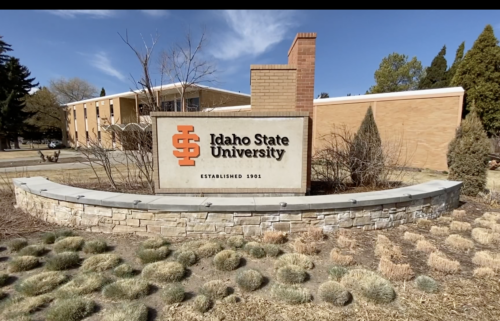“We can’t take that kind of hit” – Local farmers fear water cut off
UPDATE June 12, 2024: IDAHO FALLS, Idaho (KIFI) — Over 100 farmers in the Bonneville-Jefferson Groundwater District gathered at Melaleuca headquarters Wednesday to discuss water curtailment. They are now facing cut-offs that could negatively impact their crop yields for the season.
"We have never in our lifetimes ever seen anything like the curtailment that they're calling on now."
Rep. Stephanie Mickelsen
Ground water districts in the Eastern Snake River Plain are currently negotiating with the Surface Water Coalition. They are hopeful that the current water agreement will be amended, replaced or voided.
"This plan is a life raft with a big hole in the bottom of it," said Skyler Johns, attorney for the groundwater district. "The big hole is dated water management policy that is leading toward curtailment threats every year. If we stay in this 2015 plan and keep those obligations where they were... that raft is going to fill back up and it's going to sink."
June 5, 2024: FIRTH, Idaho (KIFI) — Connie Christensen grew up working land with her grandfather. Now she worries it's all coming to an end.
Unless there is an emergency end to the curtailment order, the water cut-off won't just mean the end to their potato crop but potentially six generations of farming.
"We wouldn't be able to take that kind of a hit and continue," said Christensen. "I mean, maybe you can get a bank to carry you, but it would be crazy for the banks to carry us when we don't know if we're ever going to be able to irrigate again."
Why is the water being cut off?
Essentially this curtailment represents a battle of wills between the Idaho Department of Water Resources and the groundwater districts in eastern Idaho.
IDWR has projected a shortage of over 74,000-acre feet of surface water downstream to the Twin Falls Canal Company.
According to Idaho law, it's the responsibility of the groundwater users in eastern Idaho to make up the difference.
And they say the farmers in eastern Idaho aren't following the legally approved agreement to offset the water they pump.
Based on agreements signed in 2009 and 2016, groundwater users on the east side of the state have a number of legally approved ways to reduce their estimated impact; including providing water stored in Idaho dams and increased conservation or efficiency measures.
"This weighs very heavy on on the department and on the director," said Executive Officer at Idaho Department of Water Resources Brian Patton. "This is not something he wants to do. This is not something the department wants to do because this does interfere with people's livelihoods. We very clearly recognize that and understand that the director did not have a choice in this matter. The groundwater districts do have a choice to come back into compliance with one of their two approved mitigation plans and protect their users from curtailment."
The order was issued despite offers by the Idaho Groundwater Appropriators (IGWA), an organization representing farmers within the nine groundwater districts in eastern Idaho, and groundwater districts individually to deliver water stored in reservoirs to fully offset the effects of their groundwater use, as they have in years past.
According IGWA, the Department of Water Resources has allowed other water users to offset the water they use by returning storage water to the Snake River aquifer. However IGWA, has been told they are not allowed to do so.
“What remains is an utterly absurd situation, where hundreds of thousands of acres of farmland, and their associated economic benefits, are thrown away during a wet year to cause a small amount of additional water to overflow from the aquifer into the Snake River,” said IGWA attorney TJ Budge. “Throughout this entire process, IDWR has been inconsistent and troublingly biased against groundwater users.”
East Idaho groundwater users say the mitigation plans the state has provided are unworkable for them.
"The state claims that we have mitigation plans available to us, but all we have to do is comply with them," Jackson said. "But those mitigation plans are unworkable. They've been rendered unworkable by the department, who has interpreted them in ways that make them unworkable for us. The harm that we would do ourselves in complying with those mitigation plans would be on par with what a curtailment would do to us."
Groundwater users say under the current plans, IDWR takes the highest possible amount of water for first right holders downstream, and factor in the lowest predicted amount of water available to find the amount of shortage that *may* happen downstream.
Local News 8 asked the Department of Water Resources if that was true.
"There are several factors that go into that calculation," said Brian Patton. "Including snowpack, including reservoir levels, including irrigation need and aquifer conditions, because a fair amount of the water that goes to the surface water coalition canals does come from the aquifer, and the aquifer is still near all time lows."
IGWA says, under the current agreements even in a year like this, where the snow pack and precipitation have been fairly good, their water is still at risk of being cut off.
"They (Idaho Department of Water Resources) say we have to project the worst case scenario," said Allan Jackson. "What that means to us is that, you know, in April, there's probably always going to be injury now."
According to Eastern Idaho Groundwater Users, the curtailment would cut off 75 billion gallons of water to farmers in Jefferson County and dry up over 104 thousand acres of farmland, providing a minuscule 12 million gallons of water to farmers downstream.
They said the loss of that much farmland and crops would have a significant impact on the Idaho economy, but an even larger impact on Idaho farmers themselves.
"You're talking about tax rolls that would be cut dramatically," said Jackson. "Your schools would be underfunded. The county tax rolls would be devastated because you no longer have this tax base of the of from agriculture that would be there."
In the end, farmers like Connie Christensen believe their concerns are falling upon deaf ears.
"As a farmer, you develop an emotional connection to the land that you farm," said Christensen. "And it's a little disheartening for the state officials and the lawyers involved in this to not understand that this isn't you aren't just a farmer as an occupation. It's it's a part of who you are."
ORIGINAL STORY:
BLACKFOOT, Idaho (KIFI) - Eastern Idaho farmers have been ordered to dry up hundreds of thousands of acres of farmland, potentially inflicting hundreds of millions of dollars in economic loss to the state.
The Idaho Department of Water Resources has issued the largest curtailment of water rights in state history on May 30, 2024.
Some east Idaho farmers we spoke with say they will not survive the cut-off.
Idaho takes a "first in time" first in right approach to water. Which means, surface water users across the state usually take priority.
The Department of Water Resources has projected a shortage of over 74,000-acre feet of surface water downstream to the Twin Falls Canal Company.
According to Idaho law, it's the responsibility of the groundwater users in eastern Idaho to make up the difference.
Based on agreements signed in 2009 and 2016, groundwater users on the east side of the state have a number of legally approved ways to reduce their estimated impact; including providing water stored in Idaho dams and increased conservation or efficiency measures.
"This weighs very heavy on on the department and on the director," said Executive Officer at Idaho Department of Water Resources Brian Patton. "This is not something he wants to do. This is not something the department wants to do because this does interfere with people's livelihoods. We very clearly recognize that and understand that the director did not have a choice in this matter. The groundwater districts do have a choice to come back into compliance with one of their two approved mitigation plans and protect their users from curtailment."
The order was issued despite offers by the Idaho Groundwater Appropriators (IGWA), an organization representing farmers within the nine groundwater districts in eastern Idaho, and groundwater districts individually to deliver water stored in reservoirs to fully offset the effects of their groundwater use, as they have in years past.
According IGWA, the Department of Water Resources has allowed other water users to offset the water they use by returning storage water to the Snake River aquifer. However IGWA, has been told they are not allowed to do so.
“What remains is an utterly absurd situation, where hundreds of thousands of acres of farmland, and their associated economic benefits, are thrown away during a wet year to cause a small amount of additional water to overflow from the aquifer into the Snake River,” said IGWA attorney TJ Budge. “Throughout this entire process, IDWR has been inconsistent and troublingly biased against groundwater users.”
East Idaho groundwater users say the mitigation plans the state has provided are unworkable for them.
"The state claims that we have mitigation plans available to us, but all we have to do is comply with them," Jackson said. "But those mitigation plans are unworkable. They've been rendered unworkable by the department, who has interpreted them in ways that make them unworkable for us. The harm that we would do ourselves in complying with those mitigation plans would be on par with what a curtailment would do to us."
According to eastern Idaho groundwater users, the curtailment would cut off 75 billion gallons of water to farmers in Jefferson County and dry up over 104 thousand acres of farmland, providing a minuscule 12 million gallons of water to farmers downstream.
They said the loss of that much farmland and crops would have a significant impact on the Idaho economy, but an even larger impact on Idaho farmers themselves.







